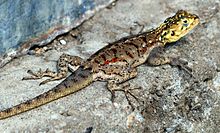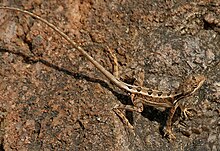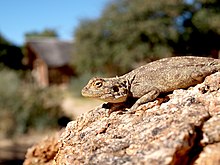Agamidae
| Agamidae Temporal range:
| |
|---|---|

| |
| MaleMwanza flat-headed rock agama(Agama mwanzae), in theSerengeti,Tanzania | |
| Scientific classification | |
| Domain: | Eukaryota |
| Kingdom: | Animalia |
| Phylum: | Chordata |
| Class: | Reptilia |
| Order: | Squamata |
| Suborder: | Iguania |
| Clade: | Acrodonta |
| Family: | Agamidae Gray,1827[1] |
| Subfamilies | |
|
6, see text | |
Agamidaeis afamilyof over 550 species ofiguanianlizardsindigenous to Africa, Asia, Australia, and a few inSouthern Europe.Many species are commonly calleddragonsordragon lizards.
Overview
[edit]Phylogenetically,they may be sister to theIguanidae,and have a similar appearance. Agamids usually have well-developed, strong legs. Their tails cannot be shed and regenerated like those ofgeckos(and several other families such asskinks), though a certain amount of regeneration is observed in some.[2][3]Many agamid species are capable of limited change of their colours to regulate their body temperature.[4]In some species, males are more brightly coloured than females,[5]and colours play a part in signaling and reproductive behaviours.[6]Although agamids generally inhabit warm environments, ranging from hotdesertsto tropicalrainforests,at least one species, themountain dragon,is found in cooler regions. They are particularly diverse in Australia.[7][8][9]
This group of lizards includes some more popularly known, such as the domesticatedbearded dragon,Chinese water dragon,andUromastyxspecies.
One of the key distinguishing features of the agamids is their teeth, which are borne on the outer rim of their mouths (acrodonts), rather than on the inner side of their jaws (pleurodonts). This feature is shared with thechameleonsand thetuatara,but is otherwise unusual among lizards. Agamid lizards are generallydiurnal,with good vision, and include a number of arboreal species, in addition to ground- and rock-dwellers. Most need to bask in the sun to maintain elevated body temperatures, meaning they are heliothermic. They generally feed on insects and otherarthropods(such as spiders), although for some larger species, their diet may include small reptiles or mammals, nestling birds, and flowers or other vegetable matter.[10]
Reproduction
[edit]The great majority of agamid species areoviparous.[11]The eggs are mostly found in damp soil or rotting logs to retain enough moisture during the incubation period. The clutch size varies from four to 10 eggs for most species, and incubation period lasts around 6–8 weeks. Specifically in the Leiolepidinae subfamily of agamids, all species use a burrowing system that reaches moist soil, where eggs are deposited in late spring/early summer or at the beginning of the dry season. The Leiolepidinae burrow system is also used for daily or seasonal retreats, as it allows them to regulate their body temperature or act as a refuge from predators.
Systematics and distribution
[edit]


Very few studies of the Agamidae have been conducted. The first comprehensive assessment was by Moody (1980)[12]followed by a more inclusive assessment by Frost and Etheridge (1989).[13]Subsequent studies were based onmitochondrial DNAloci by Maceyet al.(2000)[14]and Hondaet al.(2000)[15]and also by sampling across the Agamidae by Joger (1991).[16]Few other studies focused on clades within the family, and the Agamidae have not been as well investigated as theIguanidae.
The agamids show a curious distribution. They are found over much of theOld World,including continental Africa, Australia, southern Asia, and sparsely in warmer regions of Europe. They are absent fromMadagascarand theNew World.The distribution is the opposite of that of theiguanids,which are found in just these areas, but absent in areas where agamids are found. A similar faunal divide is found in between theboasandpythons.[17]
Subfamilies
[edit]Among the Agamidae, sixsubfamiliesare generally recognized:[18][19]
- Agaminae(Africa, Europe and south Asia)
- Amphibolurinae(Australia and New Guinea, one species in Southeast Asia)
- Draconinae(South and Southeast Asia)
- Hydrosaurinae(Hydrosaurus,Papua New Guinea, the Philippines, and Indonesia)
- Leiolepidinae(Leiolepis,Southeast Asia)
- Uromasticinae(SaaraandUromastyx,Africa and South Asia)
Evolutionary history
[edit]The oldest known unambiguous agamid isProtodracofrom the mid-Cretaceous (earlyCenomanian) agedBurmese amberof Myanmar, dating to around 99 million years ago. It is similar to primitive living Southeast Asian agamids.[20]Gueragamafrom the Late Cretaceous of Brazil may also be an agamid.[21]Jeddaherdan,a supposed agamid from the Late Cretaceous of Morocco, was later shown to be actually a youngsubfossilof the living genusUromastyx.[22]
Predator responses
[edit]Body temperature helps determine thephysiologicalstate of agamids and affects theirpredatorresponses. Apositive correlationis seen between a flight response (running speed) and body temperature of various agamidspecies.[23]At higher body temperatures, these lizards tend to flee quickly from predators, whereas at lower temperatures, they tend to have a reduced running speed and show an increased fight response, where they are more likely to be aggressive and attack predators.
Certain physical features of some lizards of these species, such asfrilled-neck lizards,play a role in theirdefensiveresponses, as well. During the mating season, males tend to display more of their frill, and give fight responses more often. Both males and females display their frills when they are threatened by predators, and during social interactions.[24]
References
[edit]- ^"Agamidae".Dahms Tierleben(in German).
- ^Thompson, M. B. (1993). "Estimate of the population structure of the e[a]stern water dragon,Physignathus lesueurii(Reptilia: Agamidae), along riverside habitat ".Wildlife Research.20(5): 613–9.doi:10.1071/WR9930613.
- ^Ananjeva, Natalia B.; Bryan L. Stuart (2001)."The Agamid lizardPtyctolaemus phuwtilmensisManthey and Nabhitabhata, 1991 from Thailand and Laos represents a new genus ".Russian Journal of Herpetology.8(3). Folium Publishing Company: 165–170.
- ^de Velasco, Jesus Barraza; Glenn J. Tattersall (September 2008). "The influence of hypoxia on the thermal sensitivity of skin colouration in the bearded dragon,Pogona vitticeps".Journal of Comparative Physiology B.178(7): 867–875.doi:10.1007/s00360-008-0274-8.PMID18491114.S2CID13413178.
- ^Cuervo, J.J.; R. Shine (10 July 2007). "Hues of a dragon's belly: morphological correlates of ventral coloration in water dragons".Journal of Zoology.273(3): 298–304.doi:10.1111/j.1469-7998.2007.00328.x.
- ^LeBas, Natasha R.; N. Justin Marshall (2000)."The role of colour in signaling and male choice in the agamid lizardCtenophorus ornatus".Proceedings of the Royal Society of London B.267(1442): 445–452.doi:10.1098/rspb.2000.1020.PMC1690562.PMID10737400.
- ^Gray, JA; Sherratt, E; Hutchinson, MN; Jones, MEH (2019)."Changes in ontogenetic patterns facilitate diversification in skull shape of Australian agamid lizards".BMC Evolutionary Biology.19(1): 7.Bibcode:2019BMCEE..19....7G.doi:10.1186/s12862-018-1335-6.PMC6325775.PMID30621580.
- ^Gray JA, Hutchinson MN, Jones ME (2019)."Exceptional disparity in Australian agamid lizards is a possible result of arrival into vacant niche".The Anatomical Record.302(9): 1536–1543.doi:10.1002/ar.24096.PMID30773845.
- ^Gray JA, Sherratt E, Hutchinson MN, Jones ME (2019)."Evolution of cranial shape in a continental-scale evolutionary radiation of Australian lizards"(PDF).Evolution.73(11): 2216–29.doi:10.1111/evo.13851.PMID31580481.S2CID203652748.
- ^Cogger, H. G. (1994).Reptiles and Amphibians of Australia(6th ed.). Port Melbourne, Vic.: Reed.ISBN978-0-7301-0088-1.OCLC35576956.
- ^Bauer, Aaron M. (1998). Cogger, H.G.; Zweifel, R.G. (eds.).Encyclopedia of Reptiles and Amphibians.San Diego: Academic Press. pp. 134–136.ISBN978-0-12-178560-4.
- ^Moody, S. M. (1980).Phylogenetic relationships and historical biogeographical relationships of the genera in the family Agamidae (Reptilia: Lacertilia)(PhD). Ann Arbor: University of Michigan. 8017324.
- ^Frost, Darrel R.; Richard Etheridge (28 September 1989)."A phylogenetic analysis and taxonomy of iguanian lizards (Reptilia: Squamata)".University of Kansas Museum of Natural History Miscellaneous Publications.81.University of Kansas Museum of Natural History: 1–65.Retrieved5 January2012.
- ^Macey, J. Robert; James A. Schulte II; Allan Larson. (2000)."Evolution and phylogenetic information content of mitochondrial genomic structural features illustrated with acrodont lizards".Systematic Biology.49(2): 257–277.doi:10.1093/sysbio/49.2.257.PMID12118408..
- ^Honda, Masanao; Hidetoshi Ota; Mari Kobayashi; Jarujin Nabhitabhata; Hoi-Sen Yong; Showichi Sengoku; Tsutomu Hikida (2000)."Phylogenetic Relationships of the Family Agamidae (Reptilia: Iguania) Inferred from Mitochondrial DNA Sequences"(PDF).Zoological Science.1991(3): 616–622.doi:10.2108/0289-0003(2000)17[527:PROTFA]2.0.CO;2.ISSN0289-0003.S2CID53607509.
- ^Joger, Ulrich (1 August 1991). "A Molecular Phylogeny of Agamid Lizards".University of Kansas Museum of Natural History Miscellaneous Publications.81(3). American Society of Ichthyologists and Herpetologists: 616–622.doi:10.2307/1446389.JSTOR1446389.
- ^Heads, Michael (2014). "3 Global affinities of Australasian Groups §Indian + Pacific Ocean Groups".Biogeography of Australasia: A Molecular Analysis.Cambridge University Press. p. 119.ISBN9781107041028.
- ^Agamidae,UniProt Taxonomy
- ^B. Ananjeva, Natalia (October 2010)."Asian Agamid lizards (Agamidae, Acrodonta, Sauria, Reptilia): Phylogenetic and taxonomic diversity".Taprobanica: The Journal of Asian Biodiversity.2(2): 65.doi:10.4038/tapro.v2i2.3144.
- ^Wagner, Philipp; Stanley, Edward L.; Daza, Juan D.; Bauer, Aaron M. (August 2021)."A new agamid lizard in mid-Cretaceous amber from northern Myanmar".Cretaceous Research.124:104813.Bibcode:2021CrRes.12404813W.doi:10.1016/j.cretres.2021.104813.S2CID233704307.
- ^Apesteguía, Sebastián; Daza, Juan D.; Simões, Tiago R.; Rage, Jean Claude (September 2016)."The first iguanian lizard from the Mesozoic of Africa".Royal Society Open Science.3(9): 160462.Bibcode:2016RSOS....360462A.doi:10.1098/rsos.160462.ISSN2054-5703.PMC5043327.PMID27703708.
- ^Vullo, Romain; Bailon, Salvador; Dauphin, Yannicke; Monchot, Hervé; Allain, Ronan (November 2022)."A reappraisal of Jeddaherdan aleadonta (Squamata: Acrodonta), the purported oldest iguanian lizard from Africa".Cretaceous Research.143:105412.doi:10.1016/j.cretres.2022.105412.S2CID253349389.
- ^Hertz, Paul E.; Huey, Raymond B.; Nevo, Eviatar (1 August 1982)."Fight versus flight: Body temperature influences defensive responses of lizards".Animal Behaviour.30(3): 676–679.doi:10.1016/S0003-3472(82)80137-1.ISSN0003-3472.S2CID53182102.
- ^Shine, Richard (May 1990). "Function and evolution of the frill of the Frillneck Lizard, Chlamydosaurus Kingii (sauria: Agamidae)".Biological Journal of the Linnean Society.40(1): 11–20.doi:10.1111/j.1095-8312.1990.tb00531.x.
External links
[edit]- Agamidae(all species) atThe Reptile Database
- "Agamidae".Atlas of Living Australia.
